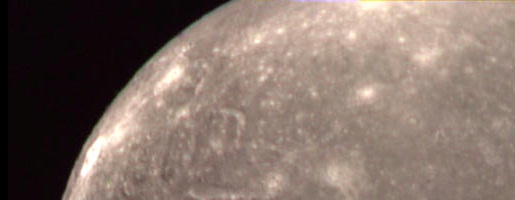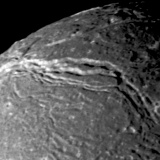 |
|||
|
The
bright craters of Ariel as seen by Voyager 2.
|
|||
| THE SURFACE OF ARIEL | |||
| Ariel has an albedo of about 0.35. Though not very reflective, it has the brightest surface in the Uranian system. Ariel appears to have had an active geological history, and must have remained active for some time. | |||
| There are three main types of terrain on Ariel, they are : cratered, ridged, and plains regions. | |||
| Ridges, grooves and canyons | |||
| Straight ridges cut through the cratered terrain. In densely ridged areas they trend in different directions creating a very chaotic landscape. The ridges often run either side of a shallow trench or graben. The ridged terrain is interpreted to have formed after the heavily cratered surfaces. | |||
 Korrigan Chasma and Sylph Chasma, both over 300 kilometres long |
 Kachina Chasmata, 600 kilometres of grooves and ridges. |
 Sylph Chasma and the 50 kilometre impact crater Melusine. |
|
| The graben found in the ridged terrain often grade into larger canyons (chasmata). Whilst the smaller graben are normally 10 to 30 kilometres across, the widths of the chasmata vary between 20 and 50 kilometres. The smooth floors of the chasmata form the third main geological unit, the plains. | |||
| The grooves may be a simple gap formed where two slow moving flows have met and squashed against one another without mixing. Such flows, if they occurred, would have erupted in line from the faults at the side of the trench and moved inwards towards the centre. Alternatively they are the actual fissures from which the central plains materials were erupted. | |||
| The most likely explanation is that they formed in the same way as some of the moon lunar rilles, that they are in fact lava tubes. The mixture of flowing water ice and contaminants, developed a chilled crust, which insulated it. When the eruption was over the roof of the tube was left with nothing to support it, and it collapsed leaving a groove. | |||
| In some places the groove changes along its length to form a ridge. This is consistent with the tube hypothesis because lava tubes do not always collapse. | |||
| Plains | |||
| In places liquid has run out from the chasmata to form more extensive plains regions. These are thought to represent later episodes of volcanism, because they overlay apparently young craters. | |||
| In general, the plains have very few craters, and are interpreted as the youngest of Ariel's surfaces. Even so, plains formation probably ceased many hundreds of millions of years ago. Variation in the density of craters from place to place implies that the plains surfaces were formed over a very long time. | |||
| Craters | |||
| The cratered surfaces appear to be the oldest even though they don't have a particularly high density. There are a few large old craters, but most probably date from after the end of the heavy bombardment period when cratering rates in the Solar System had slowed down | |||
| The very youngest features in the surface of Ariel are thought to be the craters which are surrounded by bright ejecta. Meteorite impacts excavate lighter, uncontaminated ice, depositing it on the surface. Because the ice eventually darkens, the bright patches are probably quite recent. | |||
 The bright craters of Ariel as seen by Voyager 2. |
|||
| Geological history | |||
| Ariel's distant past was dominated by impact cratering. There are also numerous interlocking fractures and graben which were formed early in Ariel's history. Tidal forces contributed to the heating effect of radioactive decay to drive Ariel's surface movement. | |||
| When the available internal heat was depleted, Ariel cooled. Because ordinary ice expands when it cools, the surface was extended and wide canyons opened up. Ridges were formed where parts of the surface were pushed together.The surface cooled gradually and as the surface ice began to expand the first narrow fissures allowed still mobile liquids to form new surfaces. It may have been too cold for liquid water, but a mixture of water, methane, or other hydrocarbons may have been able to erupt. | |||
| Changing orbital motions may also have played a role in shutting down Ariel's geological activity, by reducing the amount of tidal heating. There are two ways in which this could have been brought about. Ariel's rotation may have slowed, this is called "de-spinning". This would have happened early in its history as its rotation period came to match its orbit of Uranus. | |||
 Pixie Chasma (top) and Brownie Chasma (bottom). |
|||
|
|
|||
| Alternatively its orbital configuration with respect to Uranus' other moons may have changed. Any tidal bulge owing to a fast rotation of Ariel or a powerful and regular alignment (resonance) with Umbriel may have simply collapsed. There are no tidal resonances between Ariel and the Uranian moons today. | |||
|
|
|||